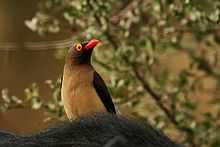Red-billed oxpecker
| Red-billed oxpecker | |
|---|---|
 | |
| Conservation status | |
| Scientific classification | |
| Kingdom: | Animalia |
| Phylum: | Chordata |
| Class: | Aves |
| Order: | Passeriformes |
| Family: | Buphagidae/Sturnidae |
| Genus: | Buphagus |
| Species: | B. erythrorhynchus |
| Binomial name | |
| Buphagus erythrorhynchus Stanley, 1814 | |
 | |
| Range of the red-billed oxpecker | |
The red-billed oxpecker (Buphagus erythrorhynchus) is a passerine bird in the starling and myna family Sturnidae; some ornithologists regard the oxpeckers to be in a family by themselves, the Buphagidae. It is native to the savannah of sub-Saharan Africa, from the Central African Republic east to South Sudan and south to northern and eastern South Africa. Its range overlaps that of the less widespread yellow-billed oxpecker.
Behavior

The red-billed oxpecker nests in tree holes lined with hair plucked from livestock. It lays 2–5 eggs, with three being the average. Outside the breeding season it forms large, chattering flocks.

The preferred habitat is open country, and the red-billed oxpecker eats insects. Both the English and scientific names arise from this species' habit of perching on large wild and domesticated mammals such as cattle and eating ticks. An adult will take nearly 100 engorged female Boophilus decoloratus ticks, or more than 12,000 larvae in a day.
However, their preferred food is blood, and while they may take ticks bloated with blood, they also feed on it directly, pecking at the mammal's wounds to keep them open to more parasites.
This is a medium-sized passerine, 20 cm long with strong feet. The red-billed oxpecker has plain brown upperparts and head, buff underparts and a pale rump. The bill is red, and adults have a yellow eyering, both clear distinctions from the related yellow-billed oxpecker. Its flight is strong and direct, and the call is a hissy crackling trik-quisss.
References
- ↑ BirdLife International (2012). "Buphagus erythrorhynchus". IUCN Red List of Threatened Species. Version 2013.2. International Union for Conservation of Nature. Retrieved 26 November 2013.
- Feare, Chris; Craig, Adrian (1999). Starlings and Mynas. Princeton University Press. ISBN 0-7136-3961-X.
- Zuccon, Dario; Cibois, Anne; Pasquet, Eric; Ericson, Per G.P. (2006). "Nuclear and mitochondrial sequence data reveal the major lineages of starlings, mynas and related taxa". Molecular Phylogenetics and Evolution 41 (2): 333–344. doi:10.1016/j.ympev.2006.05.007. PMID 16806992.
External links
| Wikimedia Commons has media related to Buphagus erythrorhynchus. |
- Red-billed oxpecker – Species text in The Atlas of Southern African Birds.
- Red-billed oxpecker videos, photos & sounds on the Internet Bird Collection
